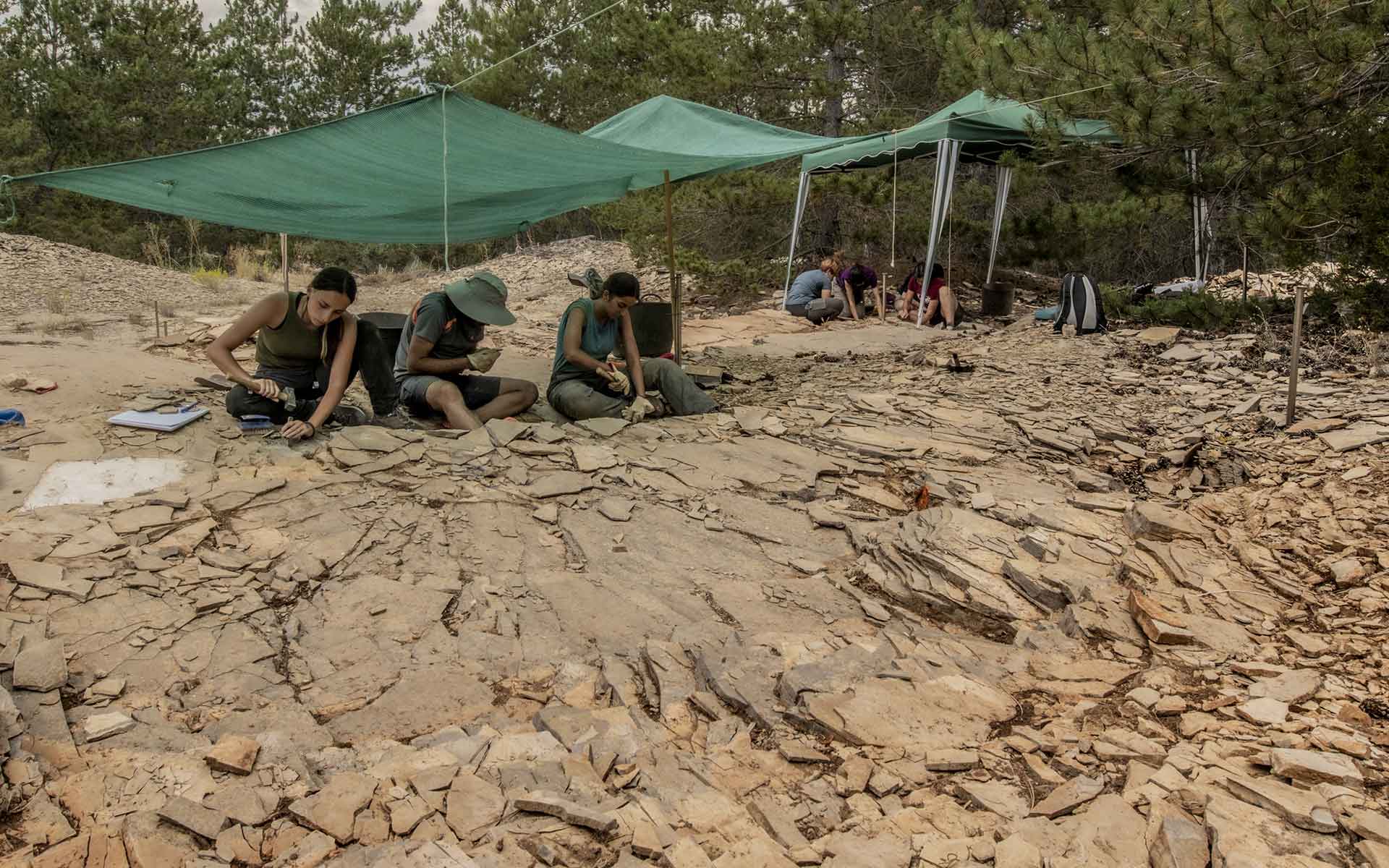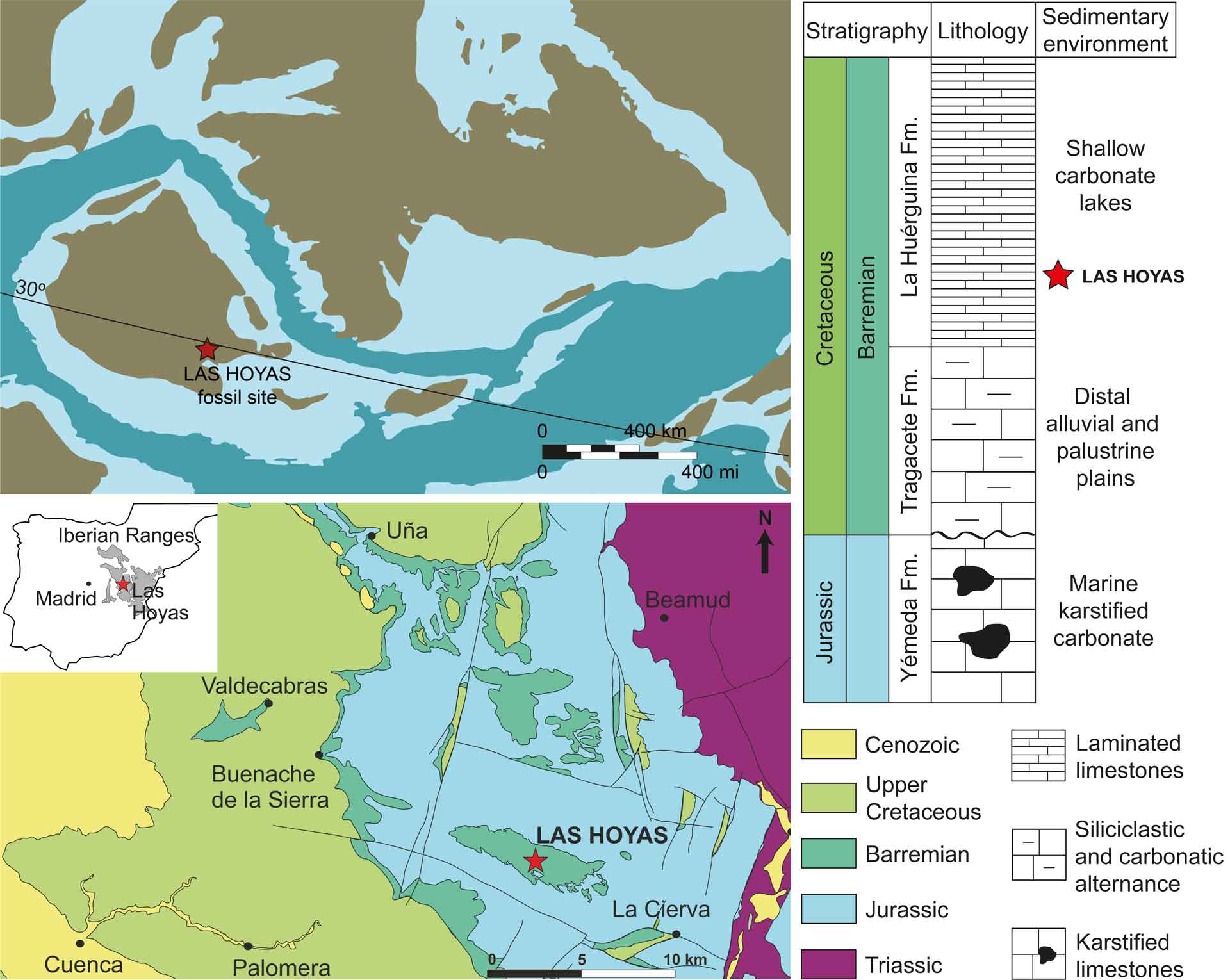
The gobiconodon early mammal Spinolestes xenarthrosus with body hair, external ear skin, and lungs in ribcage. Housed at Museo Paleontologico de Cuenca (MUPA).
Geological Period
Lower Cretaceous
Main geological interest
Paleontology
Stratigraphy and sedimentology
Location
Cuenca, Castilla-La Mancha region, central Spain, Spain
40°05’25”N, 001°53’45”W
The gobiconodon early mammal Spinolestes xenarthrosus with body hair, external ear skin, and lungs in ribcage. Housed at Museo Paleontologico de Cuenca (MUPA).
A wetland with microbial mats favoring the exceptional fossilization of animals and plants including their soft tissues.
Las Hoyas provides unique insight into the ecological structure of an Early Cretaceous wetland inhabited by microorganisms, vascular and non-vascular plants, and invertebrates and vertebrates. Its fossils exhibit the first evidences, with exquisite macro and micro details, of crucial evolutionary novelties that flourished at that time, such as seeds and flowers in the angiosperm Montsechia, modern flying apparatus in the iconic enantiornithine birds (e.g., Iberomesornis; Sanz et al., 1996), and the evolution of hair complexity and the presence of lungs in the eutriconodont mammal Spinolestes (Martin et al., 2015). The fossils are exhibited in the Museo Paleontologico de Cuenca.
- Geological description
Las Hoyas is a remarkable fossil site known for its complete Barremian wetland Biota, which includes approximately 250 species of soft-bodied organisms, plants, and animals (Marugan-Lobón et al., 2023). The site was in a microbasin within the Cuenca sub-basin of the Iberian Domain. The La Huérguina Formation, which yields the fossils, was dated by charophyte and ostracod associations, and was deposited in lacustrine and palustrine environments. The formationis composed of finely laminated limestones that were deposited in depressions formed by tectonic activity over pedogenic and karstified Jurassic marine limestones (Fregenal-Martínez and Meléndez, 2016). The locality was a shallow lake situated in an extensive, perennial, carbonate inland wetland in a subtropical climate. The lake was drained by water rich in carbonates, which was fed by karstic aquifers. The system was seasonally regulated, with water-level oscillations, favoring the growth of microbial mats. The microfacies of mats indicate drier periods with abundant fossil remains, while wetter periods are characterized by microfacies composed of fine carbonate particles and debris with a limited number of fossils. A systematic excavation layer by layer is essential for obtaining detailed information on fossil assemblages and for the recognition of ichnological evidence and microbially induced sedimentary structures.
- Scientific research and tradition
Multidisciplinary research at Las Hoyas initially focused on characterizing the diversity and evolution of the biota. Subsequently, researchers aimed to explain the exceptional preservation through actuotaphonomy, particularly emphasizing the role of microbial mats (Iniesto et al., 2015). Ongoing efforts explore paleowetland ecological complexity using network and foodweb analyses.
- Reference
Fregenal Martínez, M.A. and Meléndez Hevia, M.N. (2016) ‘Environmental reconstruction: a historical review.’, in F.J. Poyato Ariza and Á.D. Buscalioni (eds) Las Hoyas: A Cretaceous Wetland.: A multidisciplinary synthesis after 25 years of research on an exceptional fossil Lagerstätte from Spain. Friedrich Verlag, pp. 14–28. Available at: https://dialnet.unirioja.es/servlet/articulo?codigo=5757674.
Iniesto, M. et al. (2015) ‘The Impact of Microbial Mats and Their Microenvironmental Conditions in Early Decay of Fish’, Palaios, 30, pp. 792–801. Available at: https://doi.org/10.2110/palo.2014.086.
Martin, T. et al. (2015) ‘A Cretaceous eutriconodont and integument evolution in early mammals’, Nature, 526(7573), pp. 380–384. Available at: https://doi.org/10.1038/nature14905.
Marugán-Lobón, J., Martín-Abad, H. and Buscalioni, Á.D. (2023) ‘The Las Hoyas Lagerstätte: a palaeontological view of an Early Cretaceous wetland’, Journal of the Geological Society, 180(3), pp. jgs2022-079. Available at: https://doi.org/10.1144/jgs2022-079.
Navalón, G. et al. (2015) ‘Soft-tissue and dermal arrangement in the wing of an Early Cretaceous bird: Implications for the evolution of avian flight’, Scientific Reports, 5(1), p. 14864. Available at: https://doi.org/10.1038/srep14864.
Sanz, J.L. et al. (1996) ‘An Early Cretaceous bird from Spain and its implications for the evolution of avian flight’, Nature, 382(6590), pp. 442–445. Available at: https://doi.org/10.1038/382442a0.
- Author(s)
Angela D. Buscalioni.
Universidad Autónoma de Madrid, Centro para la Integracion en Paleobiología, Spain.
Jesús Marugán-Lobón.
Universidad Autónoma de Madrid, Spain.
Hugo Martín Abad.
Universidad Autónoma de Madrid, Spain.
José Luis Sanz Garcia.
Universidad Autónoma de Madrid. Real Academia de Ciencias, Spain.
José Joaquin Moratalla.
Geological and Mining Institute of Spain (IGME, CSIC).
Romain Vullo.
Université Rennes 1, France.
Candela Blanco Moreno.
Universidad Autónoma de Madrid.
Jerónimo López-Martínez.
Universidad Autónoma de Madrid, Spain.


